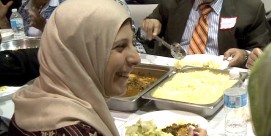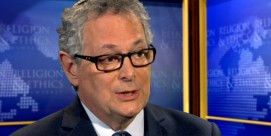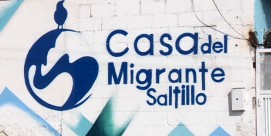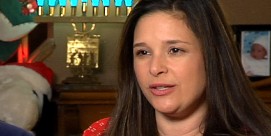In This Episode << SLIDE LEFT TO SEE ADDITIONAL SEGMENTS
Pluralism Commentary
In conjunction with our profile on Diana Eck, RELIGION & ETHICS NEWSWEEKLY invited several scholars to comment on religious pluralism in America. According to one, if you want to glimpse the future of religion in America, take a look at Flushing, Queens. Another believes that we are a religious nation because we are a nation of immigrants. And a third asserts that even in our predominantly Christian nation, religious diversity is beginning to make for some interesting new religious coalitions:
R. Scott Hanson wrote his doctoral dissertation at the University of Chicago on “City of Gods: Religious Freedom, Immigration, and Pluralism in Flushing, New York.” He is a postdoctoral research associate at Brown University.
Flushing, Queens is the most religiously and ethnically diverse community in America, with a story that mirrors the nation in microcosm.
Flushing’s town charter of 1645 was the first in colonial America to grant religious freedom. When the provision for “liberty of conscience” was jeopardized by an intolerant governor bent on persecuting anyone who was not a member of the Dutch Reformed Church, the people of Flushing came together to defend the religious minorities in their town. In 1657, they drafted the Flushing Remonstrance, declaring that “we are bound by the law of God and man to do good unto all men, and evil to no man; and this is according to the Patent and Charter of our Town given unto us in the name of the States General which we are not willing to infringe and violate … ” Their efforts proved futile, however, and it was not until 1663, when John Bowne was banished from Flushing for holding Quaker meetings in his house and then successfully appealed his case, that the town and the rest of the colony would more fully enjoy this liberty.
Today in Flushing there are ten different places of worship just on Bowne Street, named for the Quaker who defended the town charter. Hindu and Buddhist temples, Sikh gurdwaras, Muslim mosques, and Korean and Chinese churches stand next to older churches that go back to the late 17th century and alongside Reform, Conservative, and Orthodox Jewish synagogues. Services in Catholic churches are conducted in English, Spanish, and Chinese. Protestant churches of every denomination abound, including over 100 Korean (mainly Presbyterian) churches alone. All of these different places of worship and the people who attend them are densely concentrated in a small residential and commercial area encompassing just a few square miles.
After a certain point, though, it does not seem to make much difference if there are 15 or 150 different places of worship next door to each other. Flushing is interesting because it is such an extreme case and because of its place in the history of religious freedom in America, but how do people make sense of such religious diversity? How does it affect their lives, attitudes, and beliefs, if at all? What do they do with it, and what does it do to them? How have the different religious and ethnic groups in Flushing associated across boundaries over time? Where does conflict or cooperation arise?
There is quite a range of reactions. Some view the memory of Flushing’s heritage as a special blessing and are committed to the ideal of tolerance and the practice of interreligious dialogue; others have forgotten it or are simply unaware of it and see diversity only as a curse to feed their fear of change. Aside from Christians and Jews in Flushing, the numerous immigrant religious groups also have their own thoughts about the other faiths around them. There are a variety of responses to the religious plurality in Flushing, depending on who is asked.
Forty years ago, Catholic theologian John Courtney Murray asked a question that seems particularly relevant for Flushing: “How much pluralism and what kinds of pluralism can a pluralist society stand?” The extreme case of Flushing suggests that there is no limit. Indeed, the great importance of this community may be its example to the rest of the country and the world — an update of sorts on John Winthrop’s notion of “a city that is set upon a hill” and what church historian Sidney E. Mead called the “lively experiment.”
Flushing needs to be reconsidered as part of the history of religious freedom and toleration in America. It is safe to say that most Americans’ knowledge of religious freedom probably begins with Thomas Jefferson’s Virginia Statute and ends with the First Amendment. Those two acts certainly have national significance and practical meaning, but Flushing’s colonial history provides an important local context to examine the same principles on a much smaller level, in addition to a necessary historical corrective to earlier surveys of American history.
What will it mean to live with pluralism in contemporary society? Flushing is still overwhelmingly Christian and, to a lesser extent, Jewish, just like the rest of the country. But it is also confronting profound changes with the introduction of other world religions and cultures. Although there have been moments of real tension and minor conflict — over the years, there have been zoning, parking, and signage (in Chinese and Korean) complaints; newspapers have reported instances of vandalism (graffiti, eggs, destruction of lights); several attacks on new immigrants in the area, all by a white, black, and Hispanic mix of neighborhood teenagers and gang members — Flushing hasn’t experienced the same kinds of problems that have torn apart other places in the world. One reason is that historical and religious claims to territory are not as strong here as they are internationally. Another is our voluntary principle of religious disestablishment, the wisdom of the Constitution, a police precinct with a community affairs office that strives to relate to and protect the area, and the kind of vigilant “eyes on the street” that Jane Jacobs said often can be found among residents in good city neighborhoods. But diversity also seems to create tolerance over time, and the more diverse a place gets, the more tolerant it seems to become. Some or many longtime residents may move away, and those who stay may grumble about the changes and yearn for “the good old days,” but over time, a new equilibrium is reached. By contrast, conflict arises when a new group moves into a place that has been homogenous for a long time.
In 1987, to guard against any potential problems stemming from religious and ethnic intolerance or misunderstanding in the community, a group of Flushing residents, along with religious and community leaders, formed the Network for Intergroup Harmony to identify issues and promote interfaith dialogue. There is much work to be done, but NIH offers hope for the future. Meeting regularly and sitting around a table at a local church, the group sponsors annual events and is committed to being inclusive of all. On another level, local high schools also sponsor various multicultural festivals. If a more perfect civil society based not just on tolerance, but mutual understanding and respect, is to emerge in the new religious America, this is the kind of grassroots activity that other local groups across the country may wish to emulate.
Raymond B. Williams is Professor of Religion at Wabash College and Director of the Wabash Center for Teaching and Learning in Theology and Religion.
Here are two hypotheses about religion and new American immigrants:
1. Americans are more religious by some measures than people in other Western countries because we are a country of immigrants.
Every immigrant group faces the necessity of establishing its identity in a new setting, and religion functions in important ways to provide a transcendent basis for personal and group identity. For new Americans, religious identity has been a means of negotiating relations with the settled population at various stages in American history.
The years between 1920 and 1965 were a peculiar period in American history. I refer to it as “The Lull.” Immigration almost ceased due to U.S. legal restrictions, the world economic situation, the Great Depression, and World War II. The fact that there were few new immigrants during that time had a great effect on the secularization of American society and on the homogenization of American religious institutions that was related to the ecumenical movement.
The current American immigration and religious scene resembles the years between 1880 to 1920 more than “The Lull.” The likely result will be a renewed emphasis on religion as new immigrants create personal and group identities in the United States. These groups will tend to be more conservative as immigrants continue to enter and join the newly established groups. Contemporary mobility and rapid communication also permit close ties with groups and religious leaders in countries from which immigrants come in ways not possible at the end of the 19th century.
2. The increase in the Muslim population in the U.S., though probably not as great as some estimates, is nonetheless significant in at least two contexts: the relation between Muslims and Jews, and the relation between African-American Muslims and African-American Christians. Each of those is potent, with significant implications for American domestic policy and foreign relations.
Tony Carnes is co-editor with Anna Karpathakis of NEW YORK GLORY: RELIGIONS IN THE CITY and chairman of the Columbia University Seminar on Contents and Methods in the Social Sciences. He also directs the Research Institute for New Americans.
Christianity will continue to be the dominant religious framework in the United States. Muslims, Buddhists, and Hindus, after all, make up only 2 to 4 percent of the population. Consequently, Americans will still largely define their religious identity in terms of dealing with a predominantly Christian nation.
Furthermore, a large majority of the new immigrants are Christian, and their presence is fostering a renaissance of urban Christianity, particularly evangelical Protestant and Roman Catholic Christianity. Some Christians are proclaiming a new urbanism, “a Glorious Urbanism.” This new vision will tone down the “Sodom and Gomorrah” image of cities while bolstering faith-based social initiatives.
Migration to the United States is freeing people to experiment with new religious identities. As a result, there is a distinct increase in the number of evangelical Protestant congregations made up of immigrants from countries that have had few evangelicals because of persecution.
Liberal religionists will take heart that an increased religious pluralism supports their universalist theological convictions. Secularists will feel beset on all sides by opponents and vindicated by increasing conflicts among the religions. But conservative Christians will find new allies among Muslims, Buddhists, and Confucians who stress the importance of religion, the search for absolute truth, and moral values, particularly family and sexual values. This conservative coalition is even now a powerful counterweight to liberals in American cities.







